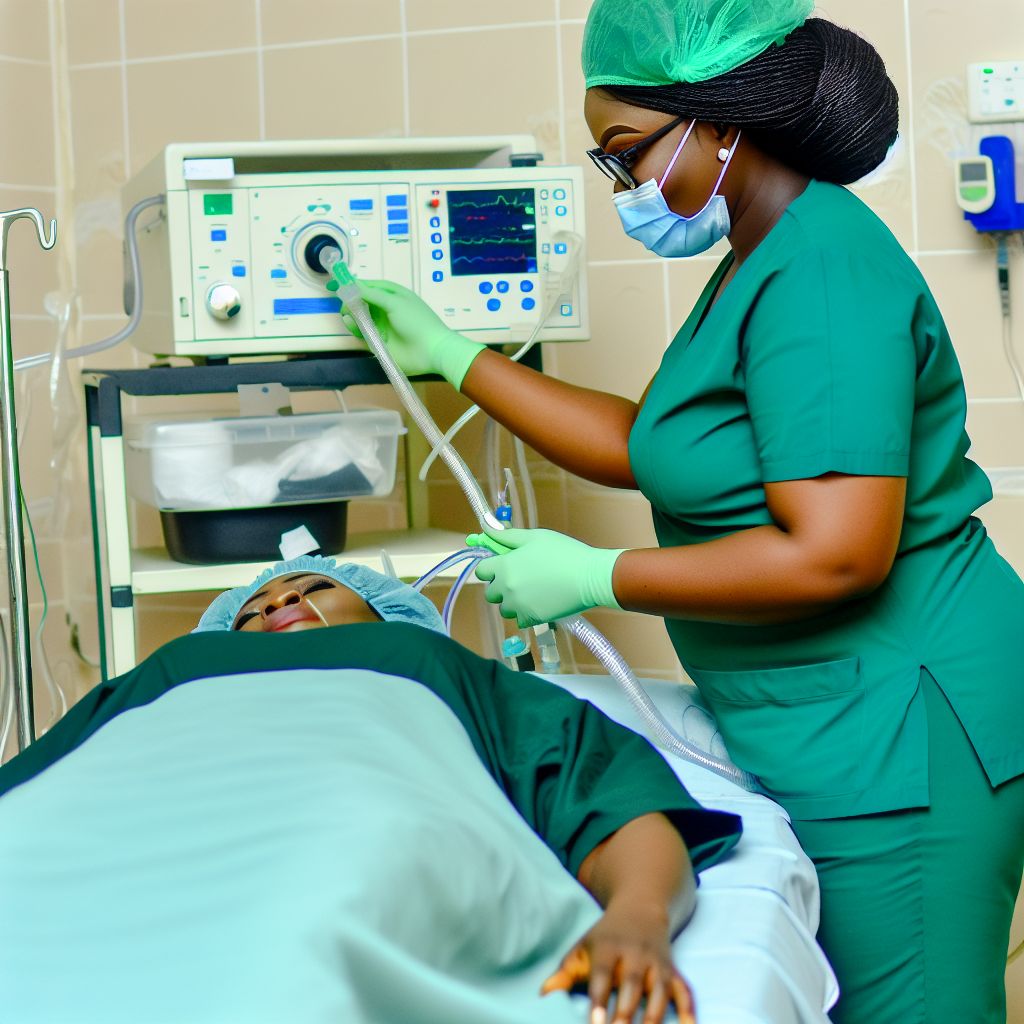Introduction:
Anaesthesiology in Nigeria has made significant strides in recent years.
The field is expanding to meet the growing healthcare needs of the population.
Anaesthesiology is a branch of medicine that deals with the use of anaesthetics.
It provides pain relief and sedation for patients undergoing medical procedures or surgery.
In Nigeria, anaesthesiologists play a crucial role in ensuring patient safety.
They focus on the well-being of patients before, during, and after surgery.
Patient safety is of utmost importance in anaesthesiology.
This is because it involves the administration of potent medications.
These medications can have serious implications if not carefully monitored.
The anaesthesiologist is responsible for assessing the patient’s medical history.
They determine the appropriate type and dosage of anaesthesia.
Additionally, they closely monitor the patient’s vital signs throughout the procedure.
The anaesthesiologist must also be prepared to manage any complications that may arise.
This is essential to ensure the patient’s safety and well-being.
As the field of anaesthesiology continues to evolve in Nigeria, prioritizing patient safety remains crucial.
This is essential for providing high-quality healthcare services to the population.
The Current State of Anaesthesiology in Nigeria:
Anaesthesiology in Nigeria has made significant strides in recent years.
However, there are still challenges that need to be addressed.
Anaesthesiologists play a crucial role in ensuring patient safety during surgeries and medical procedures.
There is a need for improvement in various aspects of anaesthesiology in the country.
Challenges Faced by Anaesthesiologists in the Country:
One of the major challenges faced by anaesthesiologists in Nigeria is the lack of adequate resources and infrastructure in hospitals.
This includes a shortage of essential equipment, medications, and trained staff.
Anaesthesiologists often have to work in stressful conditions due to these constraints.
This can impact patient safety.
Lack of Resources and Infrastructure in Hospitals:
Many hospitals in Nigeria lack basic resources for anaesthesia.
This includes ventilators, monitoring devices, and emergency medications.
Such shortages can make it difficult for anaesthesiologists to provide optimal care.
Inadequate infrastructure, such as operating rooms and recovery areas, also poses challenges.
Need for Improvement in Training and Education:
Another area requiring attention is the training and education of anaesthesiologists in Nigeria.
While there are training programs available, these need enhancement to meet international standards.
Continuous education and training are essential for anaesthesiologists to stay updated.
They need to learn about best practices and techniques in the field.
- Enhancing resources and infrastructure in hospitals.
- Providing adequate training and education for anaesthesiologists.
- Implementing quality control measures to ensure patient safety.
- Collaborating with international organizations to improve standards.
Enhancing Anaesthesiology for Better Outcomes:
Anaesthesiology in Nigeria is a vital part of the healthcare system.
However, improvements are needed to enhance patient safety.
Addressing challenges such as resource constraints, inadequate infrastructure, and training deficiencies will greatly benefit the field.
By investing in these areas, Nigeria can strive towards better patient outcomes.
A stronger healthcare system will ultimately enhance anaesthesia care in the country.
Importance of Patient Safety in Anaesthesiology
Patient safety in anaesthesiology is crucial as it ensures the well-being and health of individuals undergoing surgical procedures.
It involves preventing errors, injuries, accidents, and infections during the administration of anaesthesia.
Risks Associated with Anaesthesia
- Complications such as allergic reactions, breathing problems, and nerve damage can occur during anaesthesia.
- Patients may experience postoperative cognitive dysfunction, nausea, vomiting, or delayed recovery after anaesthesia.
- Incorrect dosages of anaesthetic agents can lead to cardiovascular collapse or even death in extreme cases.
Role of Anaesthesiologists in Ensuring Patient Safety
Anaesthesiologists play a vital role in ensuring patient safety by:
Transform Your Career with Expert Guidance
Get personalized mentorship consulting that’s tailored to your unique path. Our expert advice is actionable and exclusive.
Get Started- Conducting pre-operative assessments to evaluate the patient’s medical history and determine the safest anaesthetic plan.
- Monitoring the patient’s vital signs and adjusting anaesthetic levels during surgery to prevent complications.
- Managing postoperative pain and providing appropriate pain relief strategies to enhance recovery and comfort.
Strategies for Promoting Patient Safety in Anaesthesia
- Implementing checklists and protocols to ensure accurate medication administration and equipment checks before surgery.
- Utilizing technology such as electronic medical records and automated monitoring systems to track patients’ progress and prevent errors.
- Encouraging open communication and teamwork among healthcare professionals to address any concerns or issues promptly.
- Participating in ongoing training, education, and certification programs to stay updated on the latest anaesthesia techniques and safety guidelines.
Anaesthesiologists must adhere to strict protocols, continuously monitor patients, and employ risk-reduction strategies to ensure a safe and effective anaesthetic experience for all individuals.
Learn More: Specializations in Physiotherapy: Nigerian Options
Anaesthesiology and Patient Safety in Nigeria
When it comes to anaesthesiology and patient safety in Nigeria, there have been various incidents that have highlighted the importance of ensuring the well-being of patients and healthcare providers.
These incidents serve as valuable lessons for the healthcare industry in the country.
An Overview of Anesthesia-Related Incidents in Nigeria
Anaesthesia-related incidents can have serious consequences for patients and healthcare providers.
In Nigeria, there have been cases where patients have experienced adverse effects during or after anaesthesia administration.
These incidents range from medication errors to equipment malfunctions, highlighting the need for improved safety measures in anaesthesiology practices.
Case Studies of Patient Safety Incidents in Anaesthesiology
- A patient developed complications due to an incorrect dosage of anaesthesia medication.
- Equipment failure during surgery led to a delay in administering anaesthesia, resulting in patient distress.
- An anaesthesiologist failed to monitor a patient’s vital signs adequately, causing a post-operative complication.
Impact on Patients and Healthcare Providers
Patients who experience safety incidents during anaesthesia may suffer from physical and emotional trauma.
Healthcare providers involved in these incidents may face legal repercussions and emotional distress.
Additionally, these incidents can erode trust in the healthcare system and impact the reputation of medical facilities.
Lessons Learned from These Incidents
- Improved communication among healthcare teams is essential to prevent errors in anaesthesia administration.
- Regular training and education for anaesthesiologists and support staff can enhance patient safety practices.
- Implementing standardized protocols for anaesthesia delivery and monitoring can reduce the risk of incidents.
- Encouraging a culture of transparency and reporting can help identify and address potential safety issues in anaesthesiology.
Anaesthesiology plays a crucial role in ensuring patient safety during surgical procedures.
By learning from past incidents and implementing appropriate measures, healthcare providers in Nigeria can significantly improve the quality of care and enhance patient outcomes in anaesthesiology.
Gain More Insights: Radiographers’ Code of Ethics in Nigeria
When it comes to anaesthesiology in Nigeria, patient safety is of utmost importance.
To ensure that patients receive the best care possible, there are several initiatives in place to improve patient safety in this field.
Role of Regulatory Bodies in Setting Standards
- Regulatory bodies play a crucial role in setting and enforcing standards for anaesthesiologists.
- They ensure that professionals adhere to best practices, guidelines, and protocols to safeguard patient safety.
- These bodies also monitor and evaluate the quality of care provided by anaesthesiologists in Nigeria.
Training Programs for Anaesthesiologists on Patient Safety
- Ongoing training programs are essential to keep anaesthesiologists updated on the latest advancements in patient safety.
- These programs focus on enhancing communication skills, decision-making abilities, and crisis management techniques.
- By investing in continuous education, anaesthesiologists can provide safer and more efficient care to patients.
Collaboration with Other Healthcare Professionals to Enhance Patient Safety
- Collaboration among healthcare professionals is key to improving patient safety in anaesthesiology.
- Working closely with surgeons, nurses, and other specialists can help in identifying and addressing potential risks during procedures.
- By fostering a team-based approach, healthcare providers can create a culture of safety and accountability in the operating room.
Patient safety in anaesthesiology in Nigeria is a multifaceted issue that requires a comprehensive approach.
By implementing initiatives such as training programs, collaboration with other healthcare professionals, and adherence to standards set by regulatory bodies, anaesthesiologists can ensure that patients receive safe and effective care.
Explore Further: Continuing Professional Development for Radiographers

Preoperative Assessment and Planning
Before any surgery or procedure that requires anaesthesia, it is crucial for healthcare providers to conduct a thorough preoperative assessment of the patient.
This assessment should include a review of the patient's medical history, current medications, and any allergies they may have.
The goal is to identify any potential risk factors that could impact the administration of anaesthesia and devise a plan to mitigate these risks.
- Review medical history and allergies
- Assess current medications
- Identify potential risk factors
- Create a plan to mitigate risks
Monitoring During Surgery
Once the patient is under anaesthesia and the surgical procedure has begun, continuous monitoring is essential to ensure their safety.
This monitoring should include vital signs such as blood pressure, heart rate, and oxygen levels.
Any deviations from normal should be promptly addressed to prevent complications.
Additionally, the anaesthesiologist must remain vigilant throughout the procedure to adjust the level of anaesthesia as needed.
- Continuous monitoring of vital signs
- Promptly address any deviations from normal
- Adjust anaesthesia levels as needed
- Remain vigilant throughout the procedure
Postoperative Care and Follow-up
After the surgery is complete, the patient's safety continues to be paramount during the recovery phase.
Adequate postoperative care and monitoring are essential to prevent complications such as respiratory issues, infections, or adverse reactions to medications.
Patients should be closely monitored in the immediate postoperative period and provided with clear instructions for their care at home.
Follow-up appointments should also be scheduled to ensure the patient's ongoing recovery and well-being.
- Provide adequate postoperative care
- Monitor for complications such as infections
- Give clear instructions for home care
- Schedule follow-up appointments for ongoing recovery
By following these best practices for ensuring patient safety in anaesthesiology, healthcare providers in Nigeria can help minimize risks and optimize outcomes for their patients.
It is essential to prioritize patient safety at every stage of the anaesthesia process to ensure the best possible care and outcomes.
You Might Also Like: Radiology and Radiography Conferences in Nigeria
The need for a culture of safety in anaesthesiology:
Ensuring patient safety should be the top priority in anaesthesiology practices.
It is crucial to create a culture of safety that permeates every aspect of patient care.
This culture of safety involves not only the healthcare providers but also the patients themselves.
By fostering an environment where safety is paramount, healthcare providers can significantly reduce the risk of adverse events and improve patient outcomes.
Encouraging reporting of safety incidents:
One of the key components of a culture of safety is the encouragement of reporting safety incidents.
Healthcare providers should be encouraged to report any safety concerns or incidents that occur during patient care.
By reporting these incidents, healthcare providers can identify potential risks and take proactive measures to prevent future occurrences.
Reporting safety incidents also allows for a thorough investigation to determine the root causes and implement necessary changes to prevent similar incidents in the future.
Implementing quality improvement initiatives:
To enhance patient safety in anaesthesiology, it is imperative to implement quality improvement initiatives.
These initiatives can include regular audits, performance evaluations, and feedback mechanisms to identify areas for improvement.
By continuously monitoring and evaluating the quality of patient care, healthcare providers can make necessary changes to enhance safety and quality outcomes.
Quality improvement initiatives also help to standardize best practices and ensure consistency in patient care delivery.
Building a culture of transparency and accountability:
Transparency and accountability are essential components of a culture of safety in anaesthesiology.
Healthcare providers should strive to be transparent in their practices and communicate openly with patients about their care.
Transparency helps to build trust between healthcare providers and patients, leading to better communication and improved patient outcomes.
Furthermore, accountability ensures that healthcare providers take responsibility for their actions and adhere to established safety protocols.
By fostering a culture of transparency and accountability, healthcare providers can create a safe environment for patients and reduce the likelihood of medical errors.
Anaesthesiology and Patient Safety in Nigeria
Ensuring patient safety in anaesthesiology is crucial for successful medical procedures.
Proper training and adherence to guidelines are essential for reducing risks.
Regular monitoring and communication between healthcare teams can prevent errors.
Implementing safety protocols is necessary to enhance patient outcomes and experiences.
Patient safety should be a top priority for healthcare providers in Nigeria.
Importance of Patient Safety in Anaesthesiology
Recap of the importance of patient safety in anaesthesiology.
Call to action for healthcare providers and policymakers to prioritize patient safety in Nigeria.




